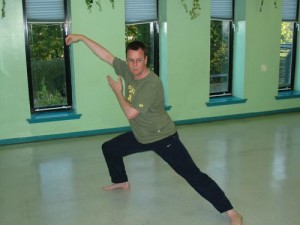What is Taiji Quan (Tai Chi Chuan)?
Taiji Quan (pronounced Tai Chee Chwan) is said to have been created by Chang Sang-Feng, a Taoist priest, during the T’ang dynasty in China about 700 years ago. It is sometimes described as “Shadow Boxing” or “Active Meditation. Fundamentally, it is a martial art that not only embraces philosophy and self-defence but also consciousness, psychology and medicine. Taiji is a Chinese Internal martial art – Neijia – where the emphasis is on exercising body, mind and spirit.
However, the quan, or martial, aspect of Taiji Quan is, probably, studied by less than ten percent of those who practice Taiji, with the vast majority focussing on the health and wellbeing that continued practice, of the forms, can bring.
Taiji Quan is the most popular of all the Internal martial arts forms around the world with Yang Family Style being the most prolific. The meaning of Taiji is Grand Ultimate Fist or Supreme Ultimate Fist – this is not an egotistical claim to be the best martial art, it refers to the Taiji symbol, (more commonly known as the Yin/Yang symbol), which itself symbolizes the Universe (past, present, and future). As with all other arts, Taiji has become much more diverse as it different families and teachers, through the millennia, have influenced the moves/application/style. But through all this, even with the diversity of styles, the essence of the Internal Art must remain for any of these styles to be truly called Taiji.
The natural way of movement of Taiji is only achieved when there is harmony between the movement of the body, mind and spirit. The carefully structured patterns of the Taiji form reflect the Taoist views of the universe. Throughout the form, and indeed throughout life when one lives within the principals of Taiji, the Shen is lifted, making the upper body light and flexible, while the Qi is sunk, and feet are planted solidly on the earth. In Taoist philosophy, this is seen as symbolizing man’s position standing between the heavens and earth.
For centuries the Chinese have recognised the incredible health benefits of Taiji. Its effects can be categorized into three separate but interconnected groups: –
- The effects on internal physiological balance and equilibrium.
- The effects on postural balance.
- The effects on psychological balance.
Although some of these effects are quick to be appreciated, it may be some time before others are appreciated. The initial effects are usually seen in more relaxed musculature and breathing, leading to better circulation and also to a change in brain-wave from beta to alpha (this often occurs more quickly through Qigong) that sets up a feedback loop encouraging deeper relaxation and awareness.
Taiji constitutes a holistic approach to health and it is now being advised along with Qigong by some western doctors for people with stress disorders, or angina, and is now being recommended as a post heart bypass exercise. It seems that the West is beginning to appreciate the centuries of accumulated knowledge of the East.
The emphasis, in the main, is now on the health aspects of the art, but this is only one facet and by ignoring the other facets, the true essence of Taiji can never be experienced. It is important therefore to find a teacher who can not only “do the form” but who also has knowledge and experience of Qi, the healing aspects, the spiritual (Shen) aspect, and the martial aspect of the art.
